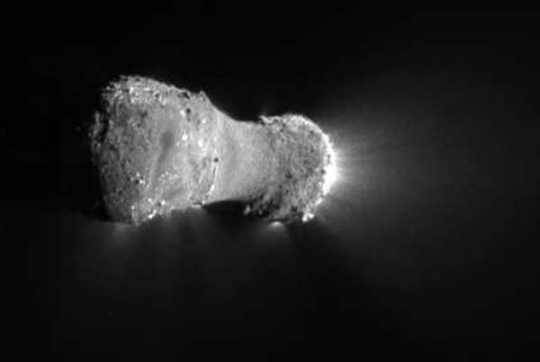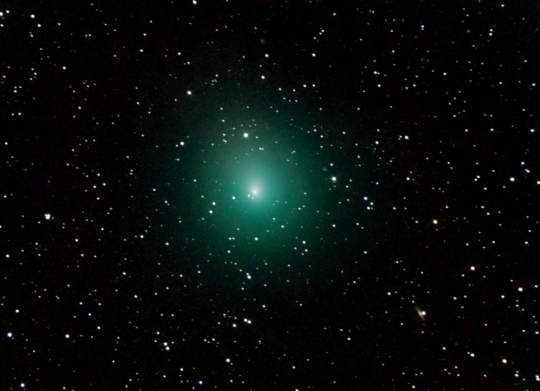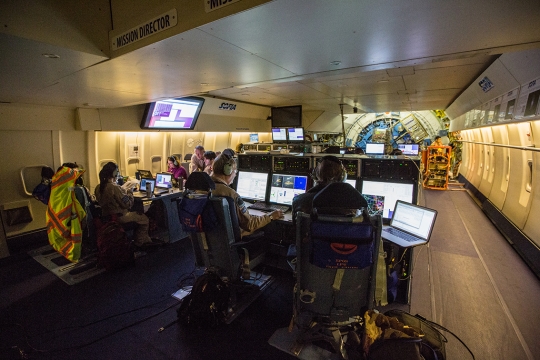‘Hyperactive’ comets tend to call attention to themselves. Take Comet Hartley 2 (103P/Hartley), which was visited by the EPOXI mission (formerly Deep Impact) in November of 2010. Three months of imaging and 117,000 images and spectra showed us just how much water and carbon dioxide the little comet was producing in the form of asymmetrical jets, a level of cometary activity that made the comet, in the words of one researcher, ‘skittish.’ It was, said EPOXI project manager Tim Larson at the time, “moving around the sky like a knuckleball.”

Image: Comet Hartley 2, in every sense of the term a moving target. Credit: NASA.
Nor is Hartley 2 alone. Scientists had a good look at comet 46P/Wirtanen from the SOFIA airborne observatory [Stratospheric Observatory for Infrared Astronomy] last December. Here again we see a pattern of hyperactivity, with a comet releasing more water than the surface area of the nucleus would seem to allow. The excess draws on an additional source of water vapor in these comets, ice-rich particles originally expelled from the nucleus that have undergone sublimation into the cometary atmosphere, or coma. Moreover, it’s water with a difference.
For if there is one topic that draws the attention of all of us interested in the early Solar System, it’s the question of where Earth’s water comes from. A standard model of the protosolar nebula has temperatures in the terrestrial planet zone too high for water ice to survive, which would mean that the Earth accreted dry, and present-day water would have been delivered later, by comets or asteroids. Other models of in situ production of Earth’s water are also in contention, so the field is far from won by comets, asteroids or other mechanisms.
One way to study the comet possibility is through isotopic ratios, where we have two forms of a chemical element with different mass. Thus deuterium, which is a heavier form of hydrogen, can be measured in the deuterium/hydrogen, or D/H ratio. Data from Oort Cloud comets have tended to run twice to three times the value of ocean water, making them an unlikely contributor to the early Earth. But we also have three hyperactive comets — 03P/Hartley, 45P/Honda-Mrkos-Pajdušáková and 46P/Wirtanen — with the same D/H ratio as Earth’s water. That would imply that such comets could indeed have delivered water to the Earth.
Thus the interest in 46P/Wirtanen shown by European researchers at the Paris Observatory and the Sorbonne, affiliated with the French National Center for Scientific Research, who are behind the recent observations. Their analysis of the D/H ratio in this comet and other comets with known ratios shows that “…a remarkable correlation is present between the D/H ratio and hyperactivity.”

Image: The comet 46P/Wirtanen on January 3, 2019. Credit: © Nicolas Biver.
Although we seem to be seeing a clear distinction between Oort Cloud comets and Jupiter-family comets, we have to tread carefully. We also find that another Jupiter-family comet — 67P/Churyumov-Gerasimenko — has a D/H ratio three times Earth normal, while Oort cloud comet C/2014 Q2 has a ratio like Earth’s. So there’s no easy dividing line, leading the authors to add the suggestion “…that the same isotopic diversity is present in the two comet families.”
If that is the case, what makes cometary activity correlate in an inverse manner with the D/H ratio, so that the ratio in hyperactive comets decreases and approaches that of Earth water?
In a paper just published in Astronomy & Astrophysics, the researchers determined the active fraction — the fraction of nucleus surface area that it would take to produce the observed amount of water in the cometary atmospheres. They did this for all comets with a known D/H ratio. What they found was that the more a comet leans toward hyperactivity, the more its D/H ratio decreases and approaches that of the Earth. Out of this grows a hypothesis.
Hyperactive comets derive part of their water vapor from sublimation of icy grains expelled into their atmosphere, while non-hyperactive comets do not. These are processes that can show distinct D/H ratio signatures. Perhaps hyperactive comets provide a better glimpse of the ice within their nuclei, which turns out to be like that of Earth’s oceans. Those comets whose gas halo is produced only by surface ice do not show detectable ratios that are representative of what is available within the nuclei. If this is the case, then most comets have nuclei similar to terrestrial water, and comets can again be considered a major water source for Earth.

Image: Scientists at work aboard a Boeing 747 SOFIA Credit: © Nicolas Baker/IRAP/NASA/CNRS Photothèque.
We’re early in the game and other hypotheses are likewise in play. Hyperactive comets could belong to a population of ice-rich comets that formed just outside the snow line in the protoplanetary disk, indicating formation in a planetesimal. Or they could have formed in the outer regions of the solar nebula, which could also show a decrease in the D/H ratio.
But the most intriguing hypothesis remains the one suggesting that our measurements of D/H ratios are not representative of what is in the cometary nucleus. From the paper:
An alternative explanation is that the isotopic properties of water outgassed from the nucleus surface and icy grains may be different, owing to fractionation processes during the sublimation of water ice. The observed anti-correlation can be reproduced with two sources of water contributing to the measured water production rate and the active fraction: D-rich water molecules released from the nucleus and an additional source of D-poor water molecules from sublimating icy grains… Laboratory experiments on samples of pure ice show small deuterium fractionation effects… In experiments with water ice mixed with dust, the released water vapor is depleted in deuterium, explained by preferential adsorption of HDO on dust grains…
So a lot of ideas are in play, which means we need more accurate D/H measurements from both Oort comets and Jupiter-family comets. We need to find out whether hyperactive comets are simply showing us the norm; i.e., comets may all contain water very similar to what we have on Earth. And that would put comets back into play as a major contributor to Earth’s oceans.
“This is the first time we could relate the heavy-to-regular water ratio of all comets to a single factor,” notes Dominique Bockelée-Morvan, a scientist at the Paris Observatory and the French National Center for Scientific Research and second author of the paper. “We may need to rethink how we study comets because water released from the ice grains appears to be a better indicator of the overall water ratio than the water released from surface ice.”
The paper is Lis et al., “Terrestrial deuterium-to-hydrogen ratio in water in hyperactive comets,” Astronomy & Astrophysics Vol. 625, L5 (May 2019). Abstract / preprint.



Could this be an alternate explanation:
“Jumping drops get boost from gravity”
Using superhydrophobic surfaces, which have nano-pillars and a hydrophobic coating, water droplets can unleash the power of surface tension whenever two or more drops touch and merge together, to jump away from the surface regardless of the orientation of that surface. However, not all droplets make a clean getaway.
“There are some droplets that either fail to jump, or fall back on the surface,” Boreyko explained. “Those droplets can then join with others and form a buildup of condensation that coats the condenser and limits its ability to cool. For these larger droplets, where jumping has failed, draining them by gravity would be a great insurance policy.”
Historically, condensers were always oriented vertically to allow the water to drain by gravity. However, researchers looking at surface-tension-powered droplets were mostly studying the jumping phenomenon on flat surfaces and not talking about the importance of orientation.
https://phys.org/news/2019-05-boost-gravity.html
While so much can be deduced from hands-off observation, the proof may lie in the sample return.
Here’s an observation –
Early nuclear scientists used gas centrifuges to separate heavy and light isotopes. Liquid water is a vacuum is unstable and boils into fine ice crystals. Sunlight exerts a uniform pressure pushing ice crystals away.
Perhaps we’re seeing the results of fractionation of light/heavy water over many orbits, as light water is blown onto different orbits.
Just because some of the comets D H2O ratios are the same as Earth’s does not necessarily mean that Earth’s oceans all came from comets. There is evidence for Earth oceans that 4.4 billion years old and it would take more than one comet to make Earth’s oceans so the odds of a couple of comets hitting the Earth are probably large. I agree with this quote by Paul Gilster: “So a lot of ideas are in play, which means we need more accurate D/H measurements from both Oort comets and Jupiter-family comets. ” I need to see more evidence to be sure.
I think the mental picture I’ve always had (and seen on some science documentaries as well) of comets bombarding the Earth just doesn’t seem to add up to enough water to produce the oceans we see today. That of course can be very misleading based on the idea of deep time and the bombardment happening over tens or even hundreds of millions of years. So many of the perplexing mysteries, such as the source of Earth’s water, and abiogenesis may at least in part be caused by our genuine lack of appreciation or complete comprehension of deep time. How many abiogenesis experiments could have occurred on the Earth in the first few hundred million years? We just can’t truly appreciate the time scales involved.
Thank you Paul. I love to learn new things. This is something I know very little about. It is fascinating. Keep up the good work.
With water found in the mantle, doesn’t that mean that primordial water must have been at least partially from planetismals, i.e. asteroidal material, or would that be a mix of asteroidal and cometary material accreting?
Resolving the D/H ratio of water in various solar system bodies seems to require sampling rather than just remote analysis. Water on Ceres, the icy moons (low D/H like the gas planets?), comet interiors and NEA all seem like good sample missions where the D/H ratio can be measured without a sample return to Earth, using mass spec on the sample at the target. A Europa plume sample seems an obvious relatively near term mission.
This ESA site about the Rosetta mission has a nice graphic on the D/H ratios of solar system bodies.
The argumentation that in the beginning the Earth was to hot to have water is not holding any critics, it is false argumentation.
If you will apply the same (false ) approach and argumentation to Big Bang you have to conclude the there should not be any water in our Universe because it was too hot right after Big Bang…
Yes some minuscule amount of the Earth water was (is) delivered by comets too. But most of the Earth water as other chemical elements composing our planet was there from the beginning.
The new space researches shows that there is water almost on every body (asteroid, planets) in Solar System.
So , why the Earth have to be “dry exclusion” from common rules? Finally whole proto-solar-system was too hot in the beginning…
I agree. Earth’s present D/H ratio is the sum of contributions from basically all the impactors, dust grains and gas that the Earth has ever accreted, including clear back to the time when there was nothing but gas and dust where the Earth now orbits. And it didn’t just come from water, for all hydrogen containing molecules in bulk also contain traces of D.
That makes a lot of sense to me Alex T. We may never know the exact contribution from each source but it would make sense that a lot of water was already here and comets and other bodies colliding with the Earth just contributed a small amount (although over a very long period of time).
I made a mistake. My comment was supposed to say the probability of a couple of comets hitting the Earth to create are oceans was low based on the idea that our oceans are 3.8 billion years old. Maybe one comet might have supplied some water to our oceans, but I am biased against the idea that our ocean came only from comets. I agree with the idea that our most ocean came from Earth and the original accretion disk.
It sounds like the paper’s argument is that there is differentiation in the chemistry of comets with radial depth, just as there might be with Earth.
That is, in the sense where water or water ice came from.
In this particular discussion I didn’t see mention of Earth’s unusual childhood, at least in so much as the theory of the Moon being born in an early glancing impact event with a body the size of Mars. It seems that we don’t integrate a similar event into Mars or Venus early history and explain their D/H ratios in terms respectively of light gravity well (Mars) or solar proximity along with a greenhouse heating of the atmosphere (Venus). As for the Mars -like body, wonder what happened to that “thing”? Did it turn into Mars or just drop out of the picture entirely? Deus ex machina left the stage.
But given that this collision event is a good explanation for the Moon, it does not necessarily throw water where it is needed here on Earth. A collision like that would dry things out rather well. It sure did for the Moon itself.
Descriptions of the K-T impact event are terrible enough and that was only an asteroid of a few kilometers diameter. Trying to imagine if the lunar origin would create a steam bath that would eventually rain down in an ocean?
So, that, I would think, would still argue for a cometary role in providing volatiles on the Earth’s surface.
If the lunar origin theory assumes that the volatiles were delivered before the collision, then what? There were a lot more than we would otherwise have reckoned? Or maybe a lot of the material arrived after the event? There is probably a prevailing argument on that, yes?